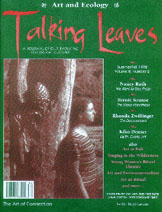The story of our revised "Frog Prince" was itself an example of metamorphosis. Grimm, the author of the fairy tale, had assumed that frogs would prefer to be princes. Willie and David had helped us stretch our imaginations through their raucous croaks and their energetic jumps around the room, so that, indeed, being a prince began to seem a little boring. They helped us all--even the little girls, who definitely wanted to "stay princesses"--understand that human beings are part of the circle of creation, including princesses, pools, frogs, and the flowers climbing the castle wall. (The truth is that, given the choice, it is unlikely that any frog today would change his place for a prince, especially in this day of tabloids and paparazzi!)
Hondi Brasco
We Want to Stay Frogs
1998 Fall | Hondi Brasco | Nancy Roth
In my sessions of pre-school creative movement classes focusing on fairy tales, we were dramatizing "The Frog Prince," the well-loved story of the frog (actually a prince under the spell of an evil witch) who was metamorphosed back into a prince through the love of a beautiful princess. When we finally arrived at the magic moment, however, Willie and David rebelled: "We don't want to be princes; we want to stay frogs!" The only solution was to improvise an alternative ending, with the help of two frogs and several princesses. In our version, the princess and the frog remained good friends, and the frog introduced the princess to his world. He taught the princess to swim in the palace pond, to jump through the palace gardens, and to sing on warm summer nights. And they lived happily ever after, with the princess happy and fulfilled--even without a prince charming!
